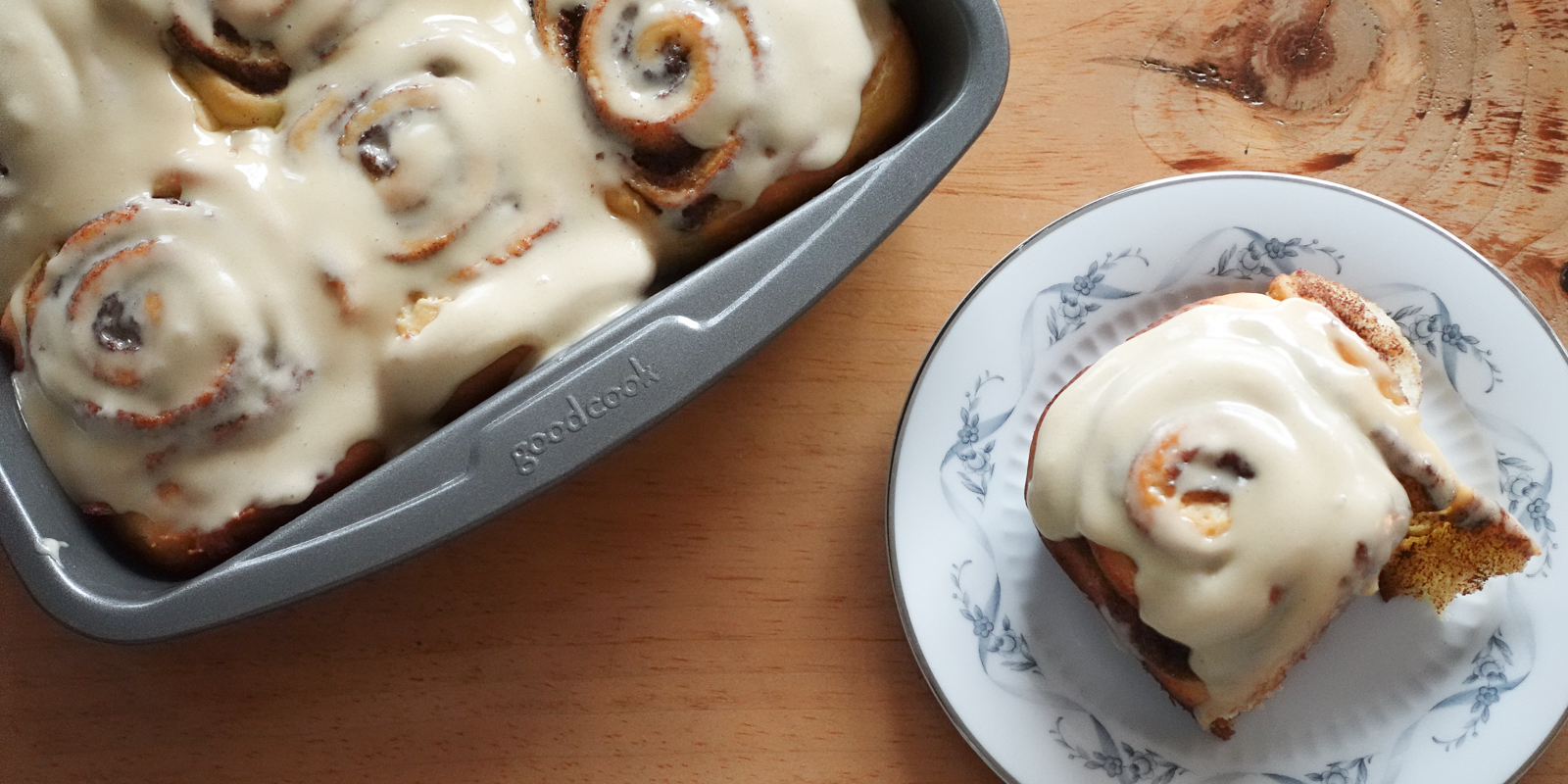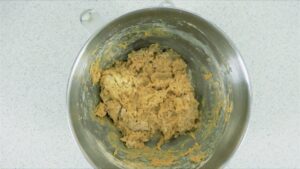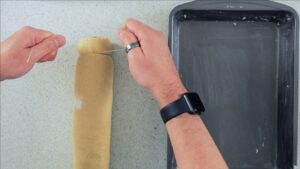This cinnamon roll recipe is so easy; perfect for beginners even if you don’t have a stand mixer. Cardamom enhances the dough’s depth of flavor, pairing well with cinnamon for added spice and warmth. The dreamy chai icing caps off an already delicious roll, giving it a unique and aromatic taste that balances sweet and spicy notes.
Cinnamon Roll Love
I’m obsessed with cinnamon rolls–always have been. Who remembers making canned varieties from the store in the toaster oven as a child? 🙋🏻♂️ I’d leave the icing packet on top to warm until I could barely touch it and delicately pour its contents to ensure maximum coverage. Then, having waited long enough for the whole process to unfold, I’d essentially attack the tray of rolls until they were demolished.
Thankfully I have better table manners as an adult, but I still get the urge to tear these rolls apart. You’d be forgiven for feeling the same once you get a taste–truth.
What Are Cinnamon Rolls?
Cinnamon rolls originated in Sweden and are known as kanelbullar. They are sweet rolls typically made with yeast and served frosted or iced. The dough is rolled out, and a combination of butter, cinnamon, and sugar is applied before being rolled up and sliced. The rolls are baked in the oven until they turn light brown on top, and the cinnamon-sugar mixture caramelizes between the layers.
Cinnamon rolls are typically served warm at breakfast, brunch, or as a dessert, especially on special occasions or during holiday gatherings when guests stay over. The only problem is they may always stay! Cinnamon rolls also make for an impressive addition to any potluck. This cinnamon roll recipe is easy to whip up in only a few hours, with most of the time spent rising while you tend to other matters.
Dough and Filling Ingredients:
- Milk: Whole milk or 2% works well in this recipe, making the dough richer and more flavorful. You can substitute with lower fat or alternative varieties, but note the flavor will be impacted.
- Granulated Sugar: This ingredient sweetens the dough and helps the yeast and flour form gluten.
- Brown Sugar: Dark brown sugar caramelizes in the best possible way in this recipe, and the slight inclusion in the dough adds richness and depth.
- Butter: Salted butter is used in the whole recipe. Unsalted butter can be used, but you’ll want to compensate for the lack of salt.
- In the dough: Add an additional 1/2 tsp.
- In the filling: Mix 1/2 tsp with the brown sugar and cinnamon.
- In the frosting: Add an additional 1/4 tsp.
- Eggs: The eggs help the dough maintain structure and shape.
- Flour: I use all-purpose flour and bread flour in this recipe. Bread flour alone makes the rolls too chewy due to the gluten content. All-purpose flour on its own can make the dough difficult. Combining the two makes the dough tender, resulting in a delicate but chewy melt-in-your-mouth adventure.
- Yeast: Fresh is best! Remember to include this ingredient since it helps the dough to rise. Instant yeast is used in this recipe and added to the dry ingredients. Active yeast can be used in its place. If doing so, mix with the warm milk and let sit for 10 minutes before continuing with the recipe.
- Cardamon: The fruity, spicy aroma and flavor enhance the dough’s aromatics and taste. If you skip this ingredient in the dough, only use 1/4 cup of granulated sugar instead of 1/3.
Frosting Ingredients
- Powdered Sugar: This ingredient helps to sweeten and thicken the icing. Add or subtract based on your preference for taste and consistency.
- Cream Cheese: This ingredient is used in the icing to balance out the butter and chai flavors. This can be adjusted based on your taste preference.
- Vanilla extract: Use pure vanilla extract for the best taste. Vanilla also pairs well with chai spices, so you’ll want to take advantage of this ingredient.
- Chai Mix: I include a simple recipe to make the spice mixture, but if you have a store-bought chai powdered mix–you can use that instead.
- Milk: You only need a little milk to help thin out the icing and make it easy to spread. For added richness, you can opt for heavy cream or half and half.
No Stand Mixer, No Problem
Knead the dough by hand using the following process:
-
- Lightly flour a clean work surface with 1 tsp of all-purpose or bread flour. Scrape the dough out of the bowl and onto the work surface.
- Lightly apply 1/2 tsp of flour to the top of the dough. Apply flour to your hands.
- Form the dough into a rough ball, and gently push the heel of your hand into the top of the dough and away from you. Grab the far end of the dough and fold it back to the center. Rotate it 90°, and repeat the process. Apply a sprinkle of flour, as needed and sparingly, if the dough sticks to the work surface when kneading.
- Continue kneading the dough until smooth, elastic, and tacky–about 6 to 8 minutes.
- Note: Use small amounts of flour at a time and only as needed. It can be tempting to wash your hands each time they get too sticky from kneading the dough. Use a flour wash instead: Rub a small amount of flour between your hands away from the dough until any stuck-on pieces are removed.
Recipe Notes
- First rise: Provide adequate time for the dough to rise in a warm spot. The dough is ready when it has doubled in size and bounces slowly back when you press into it with a floured index finger. Here are several options to help the dough rise:
- Option 1: Preheat your oven for two minutes, turn it off, and place the covered dough inside to rise with the door shut. Don’t use the range during this period.
- Option 2: Heat a cup of water in the microwave for 3-5 minutes, and move it to the side. Place the covered dough in the microwave to rise with the door shut. Don’t use the microwave during this period.
- Option 3: Preheat a dough proofer to 78°F, and add the bowl–uncovered–to the interior. Cover the proofer with its manufactured lid.
- Option 4: Place the covered dough in a warm room or windowsill. Avoid intense direct sunlight/heat.
- Use unwaxed, unflavored dental floss to cut the dough. This prevents the layers from crushing into each other, resulting in their evenness and preventing them from rising above each other as the rolls bake.
- This cinnamon roll recipe is easy! But for general recipe notes and troubleshooting, including tips on measuring dry ingredients and calibrating your oven, visit the FAQ page. You can also send me a note via the Contact page or comment below with any questions!
Storage
- Room Temperature: Store in an airtight container for up to 2 days;
- Refrigerator: Store in an airtight container or wrap the original pan in 2 layers of plastic wrap for up to 7 days.
- Freezer: Store in the original pan wrapped in 2 layers of plastic wrap and a layer of aluminum foil for optimal freshness. Let thaw overnight before warming.
Make Ahead
If you plan to bake these rolls the next day:
- Cut the rolls and place them in the prepared pan, following the recipe instructions.
- Wrap the pan of unbaked rolls in 2 layers of plastic wrap and place in the refrigerator.
- Let sit at room temperature for 45 minutes before baking. They will continue to rise during this time.
If you plan to bake these rolls within 30 days:
- Cut the rolls and place them in the prepared pan, following the recipe instructions.
- Wrap the pan of unbaked rolls in 2 layers of plastic wrap and a layer of aluminum foil and place in the freezer.
- The day before baking: Thaw overnight.
- The day the rolls will be baked: Let the rolls sit at room temperature for 45 minutes. They will continue to rise during this time.
This cinnamon roll recipe is easy and versatile, and I hope you have a blast making them!
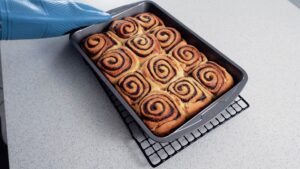
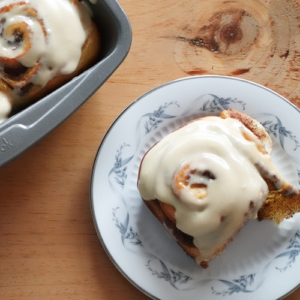
Cardamom Cinnamon Rolls with Delectable Chai Cream Icing
Equipment
- Mixing Bowls
- Measuring Spoons, Cups
- Rubber Spatula or Wooden Spoon
- Rolling Pin
- 13"x9" Baking Pan OR 9" or 10" Cake Pan
- Stand Mixer with dough hook/paddle attachment recommended, but can be done without
- Scale optional to weigh ingredients
Ingredients
For the Dough
- ¾ Cup + 1 Tbsp 2% or Whole Milk warmed to 105-115°F (40°-46°C) - 191g
- ⅓ Cup Granulated Sugar 67g
- 1 Tbsp Dark Brown Sugar 12g
- 2 Large Eggs lightly beaten, room temperature
- 5 Tbsp Salted Butter mostly melted - 70g
- 2.5 Cups Bread Flour 300g
- 1 Cup All-Purpose Flour 120g
- 2 ¼ Tsp Instant Yeast see Recipe Note - 7g
- 2 Tsp Ground Cardamom
- ¾ Tsp Table Salt 4.5g
- 1 Tsp Orange Zest optional
For the Filling
- ¾ Cup Dark Brown Sugar 165g
- 2 Tbsp Ground Cinnamon 16g
- ¼ Cup Salted Butter mostly melted - 57g
For the Chai Cream Cheese Icing
- 3 Oz Cream Cheese room temperature - 85g
- ¼ Cup Salted Butter room temperature - 57g
- ½ - 1 Cup Powdered Sugar up to 1 cup, if needed for desired consistency - 60g-120g
- 1 - 2 Tbsp Powdered Chai Mix (see notes) up to 2 Tbsp to taste - 15g-30g
- ½ Tsp Pure Vanilla Extract 2g
- 1 - 2 Tbsp 2% or Whole Milk up to 2 Tbsp, if needed for desired consistency - 15g-30g
Instructions
For the Dough
- Add warmed milk, granulated sugar, and brown sugar to a large bowl (or bowl of a stand mixer, if using). Whisk to combine, and then whisk in the eggs until incorporated.
- Slowly add the butter to the bowl while whisking until blended well.
- In a medium bowl, add the flour, yeast, cardamom, salt, and orange zest (if using) and whisk to combine.
- Add the flour mixture to the wet ingredients in 2-3 batches using a wooden spoon or rubber spatula. Stir until the dough starts forming--it should still look crumbly.
- If using a stand mixer fitted with a hook attachment: Knead the dough on medium speed for 6-8 minutes. To know that it is ready, the dough should look smooth and be tacky, and it should somewhat pull away from the sides of the bowl as it mixes. If it feels sticky and looks almost entirely stuck to the sides of the bowl with no evidence of pulling away as the hook moves about, add 1 Tbsp of Bread Flour and knead for an additional 2 minutes.
- If kneading the dough by hand: Lightly flour a work surface and pour out the dough mixture. Lightly flour the top of the dough and your hands. Shape the dough into a disk, and press the heel of your hand down and forward into the center of the dough. Rotate 90 degrees and repeat until the dough is smooth and tacky, about 6-8 minutes. If the dough is too sticky, add 1 Tbsp of Bread Flour and continue kneading. It is essential to keep your hands floured, but be careful not to add too much flour to the dough. The goal is a tacky dough when it is done.
- Grease a medium or large bowl with cooking spray or neutral oil, and place the dough in the center--flipping once to cover the entire dough in a light layer of oil. Cover the bowl with plastic wrap and put it in a warm environment to allow the dough to rise until doubled in size, about 60-120 minutes. Some recommendations for colder spaces:Rise method 1: Preheat your oven for two minutes, shut it off, and place your bowl with the dough in the warm interior.Rise method 2: Heat a cup of water in your microwave for 3 minutes. Place the container of hot water in the corner of the microwave and set the bowl with the dough inside. Close the door. Rise method 3: If using a proofer, preheat it to 78°F and place the bowl inside without a cover.
Filling and Assembly Instructions
- For 12 medium cinnamon rolls, generously butter a 13"x9" baking pan. For 9 large cinnamon rolls, generously butter a 9"x9" baking pan or 9" cake pan. You can also use parchment paper in addition to buttering the pan for additional nonstick benefit.
- Lightly flour a clean surface, add the risen dough, and lightly flour the dough surface. Shape the dough into a small rectangle.
- Flour your rolling pin, and roll the dough into a 10"x14" rectangle, with the 10" side closest to/facing you. Add a sprinkle of flour under the dough on each end once it is rolled out to prevent it from sticking to the surface.
- Spread butter evenly over the dough surface.
- In a small bowl, combine the brown sugar and cinnamon. Sprinkle the mixture evenly over the dough surface, leaving about ¼" bare at the short end farthest from you. Smooth the cinnamon sugar mixture across the surface with your hands, but don't press down while doing so.
- Roll the dough from the short end closest to you until you reach the far end, with the seam landing on the underside of the rolled dough. While rolling, use your fingers and palms to move the dough along as horizontally as possible. After each rotation, ensure the roll is tucked tightly, but don't squish the dough to make it tighter. This can result in the cinnamon sugar or layers of dough being squeezed out while baking.
- Cut off the uneven ends of the roll. Cut the rest of the roll into 12 slices (if using a 13"x9" pan) or 9 slices (if using a 9"x9" pan or 9" cake pan) using a knife or unflavored dental floss and place each slice onto your prepared pan. Let rise loosely covered with a piece of plastic wrap for an additional 30 minutes. While the rolls rise, Preheat your oven to 350°F / 176°C.
Baking the Rolls and Making the Icing
- Bake rolls until they are lightly golden brown on top, about 20-30 minutes. Let cool for 10-15 minutes before icing.
- While the rolls bake, add butter and cream cheese to the bowl of a stand (or hand) mixer, and mix with a paddle attachment on medium speed until smooth, about 2-4 minutes. This can also be done by hand, using a fork, spoon, or rubber spatula.
- Scrape the sides of the bowl, and add in the powdered sugar, 1 Tbsp chai mixture, and vanilla extract. Mix on medium speed until well combined, scraping the sides of the bowl if needed, about 2-3 minutes.
- Scrape the sides of the bowl, and add the milk. Mix on medium speed until no lumps remain, about 2-3 minutes. Check the consistency and taste of the icing, and adjust as needed:To thicken: Add 1/2 cup of powdered sugar. To thin out: Add 1 Tbsp of milk.For more flavor: Add the remaining chai mix.
- Cover the rolls with desired icing amount and serve warm.
Video
Notes
- 3/4 Tsp Ground Cinnamon
- 3/4 Tsp Ground Cardamom
- 3/4 Tsp Ground Ginger
- 1/2 Tsp Allspice
- 1/4 Tsp Ground Black Pepper
- 1/8 Tsp Ground Cloves

